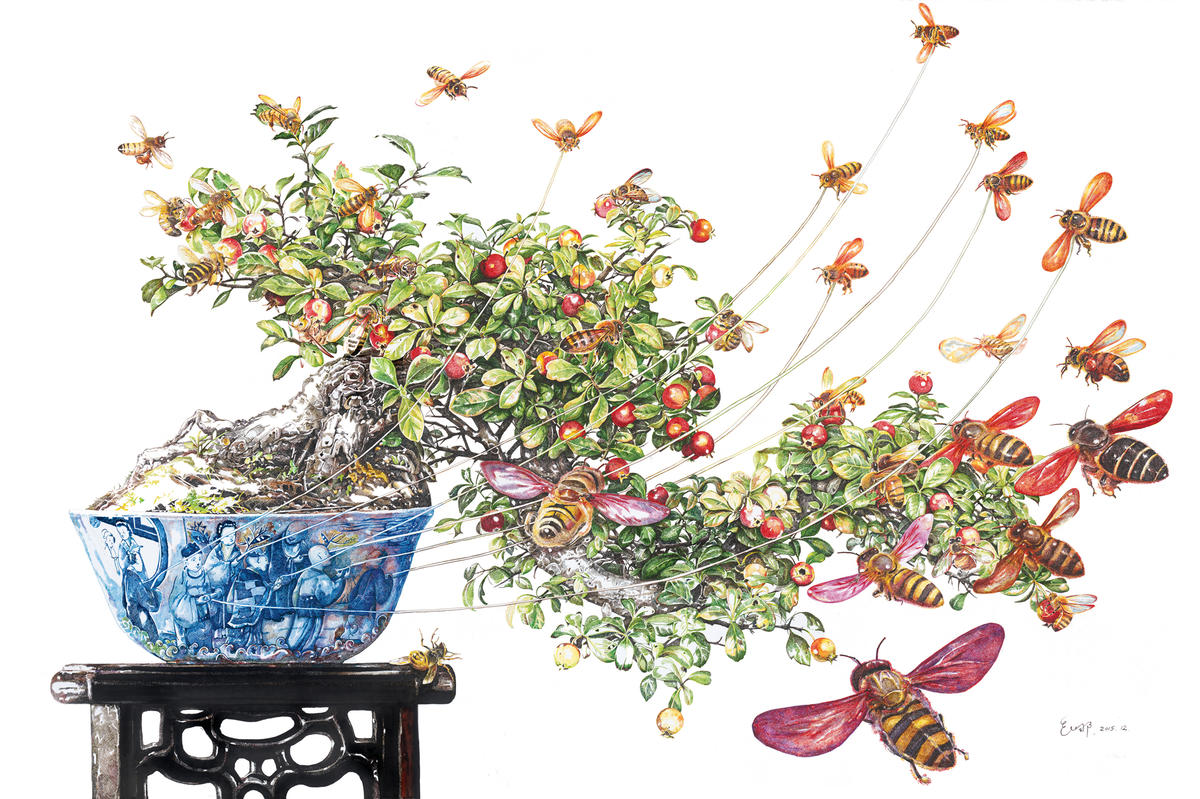在一起 青年艺术100 执行总监 赵力

学画伊始的赵娜就对黑白灰的关系非常有兴趣,而经过了央美的训练她已经将黑白灰的关系逐步发展为关乎心境与情绪微妙变化以及想象力的某种言说。当然,铅笔对于此时的画家而言则是另一种的执着,最开始赵娜很喜欢用铅笔来绘画,她迷恋于铅笔画的质感以及那些在纸上划过的铅笔线条,其中的敏感度和直接性都是她特别有感觉的东西,这些都对应于黑白灰关系的展开变成了技术的有机支撑。这一时期铅笔画的主题大多是“环境保护”这样的话题,赵娜想有意识回避了“少女风”的流行格套,以社会敏感性主题来取代仅仅关乎自我的“喃喃自语”。最初的时候,她的画题更为直接,赵娜画了很多因环境破坏而“流离失所”的动物形象,“迁徙”和“变异”成为了画中动物的明确特征,具有了很强的视觉冲击力。
很快,赵娜就发现艺术创作不仅仅需要声嘶力竭地“吶喊”,更需要具有某种的“独立”态度。于是,2011年的一次偶然经历遂成为了新的起点:“2011年的一次在机场站在步行梯上的时候,感觉步行梯在动而自己不动。当时觉得这就像时间一样,我们觉得没有变,但是时间已经在我们身边流逝,并且一去不返了”。这一年赵娜创作了一系列以“电梯”为“载体”的作品,画家依旧在说“环境保护”的问题,但是作品具有了更象征性的言说方式,即以“电梯”为时间性的隐喻,同时又营构出一个特殊的空间环境,而“抱著书和动物们在一起的女孩、倾倒在建筑上的树、巨浪滔天的灾难场景、鹿国与鸟国的战争童话等等”都在“电梯”里展开了剧情,并在戏谑与荒诞不经之中揭示了变化的永恒与冷酷。
赵娜从“电梯”系列中学会了某种的刻意“编造”,从而开始展现了个性化的视觉逻辑和叙述方式。紧接着的2012年,她又从日本艺术家池田学的作品中获得灵感,以“丸笔”来取代铅笔,以色彩来取代“黑白灰”的世界。画题的变化也更具有了某种的哲思,赵娜说“我想在自己的画中去反映这一年我有的一个很深的体会——‘安逸与危机’,我想表达这种常态中的安逸与危险,大多数危险往往出现在我们最放松警惕、最习以为常的环节,甚至那些你熟悉、信任的人和事在某些时候他们会成为打垮你的利器,这些利器对你的生活了如指掌,就像年久失修的锁、忠心耿耿的老计算机、潜伏在身体里的烟酒瘾,它们取悦你,也会在某些时候背叛你。”所谓的“安逸与危机”,无疑还是来自画家在现实生活中针对“变化”的生命体验,然而赵娜却将其不动声色地演化为某种的“并存”的画面结构,“所以,我还是以动物和植物为主,把画面画的很美,动物也很安逸,但是在不醒目的位置画出危险的动物,或者树木灌丛中隐藏着鲨鱼、蜘蛛这样的动物,以暗示着危险”。
如果说“安逸与危机”是矛盾的某种并存的话,那么2015年的赵娜在画面中更加强调的是“在一起”的理由和宿命。赵娜以单一形象的“复数”迭置与各种形象的密集变形为手段,以日常生活中的常见物品为对象,令人联想到有关毁灭、执着和爱情的叙事。只是画家更擅于从对细节的关注中走出来,从大局出发去建构出整体的画面关系,尤其是在画面主体和背景处理上,她通过对虚实的不同处理来表达某种的节奏,以产生新奇、独特的视觉效果。无论赵娜把这种的“在一起”称之为“借物喻人”或者是“异质同构”,但是它们从根本上仍然来自于画家对现实世界的某种概括与归纳。“在一起”,就是赵娜以艺术的个人方式来针对当下社会的可视化变形和迭加,同时她也揭示了某种的宿命,即集体命运的无法挣脱以及个性的迷失彷徨。
Together
Zhao Li
As Zhao Na began to study painting, the relation between black, white and grey greatly appealed to her. By the time she completed her academic formation at the Central Academy of Fine Arts (CAFA), she had already developed this relation between black, white and grey into a discourse that touched on subtle mental and emotional transitions and the imagination. Of course, as for painters nowadays, the pencil makes up another kind of obsession. At first, Zhao Na was very fond of using pencils in her works. She was infatuated with the texture of pencil drawings, made up of pencil lines streaking across the paper. She felt strongly about their sensitivity and directness. As she developed such a response to the relation between black, white and grey, it came to serve organically as technical backing for her works. During this period, the predominant themes of her pencil drawings were topics such as "environmental protection". Zhao Na consciously avoided the prevalent pattern of the "maiden archetype" (shaonü feng), wanting to substitute her merely self-referencing "inner mutterings" with themes revolving around social sensitivity. At first, the topics of her paintings were more direct, as she painted a great deal of images of animals "driven from their homes" due to environmental destruction. The notions of "migration" and "aberrance" became defining characteristics of the animals in her paintings, and gave her works an immense visual impact.
Very quickly, Zhao Na discovered that in artistic creation one mustn't merely shout oneself hoarse, but rather needs to possess an attitude of "independence". Hence, thereafter, an accidental experience in 2011 served as a new starting point: "When at one point in 2011 I was standing on an escalator, I felt as if the escalator was moving while I stayed motionless. Back then, this reminded me of time itself, where we don't feel any changes taking place, despite the fact that time is already elapsing around us, never to return again." In that year, Zhao Na created a series of works revolving around "elevators" and "carriers". The artist still touched upon issues of "environmental protection", however her works started to display a more symbolical narration, i.e. using the trope of "the escalator as a metaphor for temporality, while at the same time, plotting out a peculiar spatial environment. The plotlines of "girls accompanying animals while clinging on to books, trees toppling onto architectural structures, a tragic scene inflicted by a wall of water, bellicose fairytales about the Land of the Deer and the Land of the Birds, etc", all unfurl within the confines of the escalator. Their ludicrousness and absurdity reveal the eternity and callousness of change.
The creation of her Escalator series taught Zhao Na how to deliberately "fabricate": she began to display a personalized visual logic and mode of narration. Directly after that, in 2012, she started to draw inspiration from the works of Japanese artist IKEDA Manabu. She replaced the pencil with so-called "dip pens", and substituted the world of "black, white and grey" with the world of color. Changing the theme of her paintings made her works all the more rife with philosophical thought. In the words of the artist: "I want my works to be a reflection of a profound experience I had this year, i.e. Comfort and Peril. I want to express the sort of comfort and crisis that have become a state of normalcy. In most situations, danger occurs in those instances where we lower our guard, when we take everything for granted, to the point where the people and things you know and trust the most sometimes become sharp-edged tools that can strike you down. These devices know your life through and through, like an old lock worn down by the years without repair, a loyal and devoted computer, or a cigarette or alcohol addiction slumbering latently in the body. They can please you, yet at times they will also turn against you." The so-called Comfort and Peril series undoubtedly still comes from life experience the artist has undergone in real life in allusion to "change". However, without batting an eyelid, Zhao Na transforms this into tableau compositions of "coexistence". "This is why I still attach most importance to animals and plants, painting my pictures beautifully. The animals are very at ease, but in unsuspecting, low-key places I paint dangerous animals, or sharks and spiders hiding in the bushes, to insinuate danger."
If we were to say that the notion of Comfort and Peril is a kind of coexistence of contradictions, then the Zhao Na of 2015 puts even greater emphasis on the justification and predestination of being Together. Zhao Na uses the "complex" superposition of singular shapes and the dense transfigurations of various shapes as a tool, as she makes banal, common of everyday life into her object, causing the viewer to think of narrations related to destruction, obsession and love. The artist just happens to be more adept at moving away from a concern for detail, departing from the big picture to construct the entire pictorial relation, particularly when it comes to the body of the picture and her treatment of the backdrop. Through various ways of dealing with void and solidity, she's able to express a rhythm, thereby generating a novel and peculiar visual effect. Whether Zhao Na calls this type of "togetherness" Animals as Metaphor for Humans or Heterogeneous Homogeny, they still essentially come from the artist's generalization and induction of the real world. Together comes down to Zhao Na using an artistic, personalized method to come up with a visualized transformation and superposition aimed at contemporary society. At the same time, she has revealed a kind of predestination, i.e. the impossibility of breaking loose from a collective destiny, as well as the straying and wandering of the individual.
